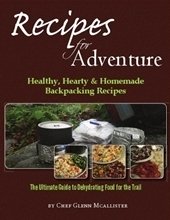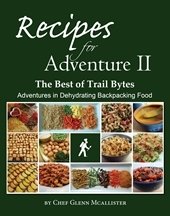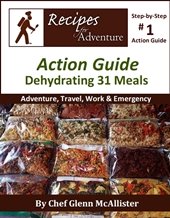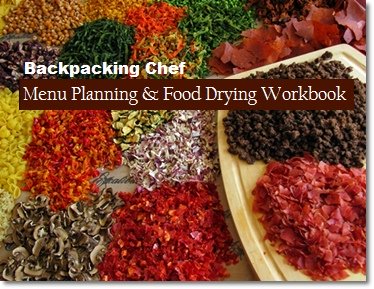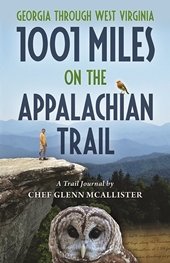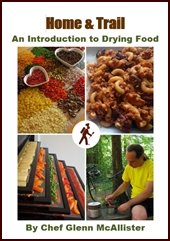Backpacking Meals & Food:
3-Day Menu with Calories

The backpacking meals and foods selected for this 3-day backpacking menu were chosen to demonstrate how many calories you would get from a combination of delicious homemade meals and energy rich snacks.
Regular or Large Portions
For each menu item I include the calories for a regular serving and a
large serving which is approximately 50% larger. The total food calories
provided per day for this menu are approximately 3000 for the regular
size column and 4000 for the large size column. The longer you are on
the trail and the more difficult the hiking conditions, the more likely
you will opt for larger portions for some or all of the menu items.
It
is almost a certainty that you will burn more calories than you consume
when backpacking, but the size of the calorie deficit varies between
individuals based on physical characteristics such as age, sex, body
size, fitness level; the difficulty of terrain and the
temperature/weather; and how hard you push yourself - load carried,
miles hiked, rest stops taken, quality of sleep, hydration, etc.
When
I first developed the backpacking recipes featured here at
BackpackingChef, I did not calculate the calories because I intuitively
knew that packing well-balanced backpacking meals and high energy snacks
would provide the nutrition and energy I needed. I kept detailed notes
about the yields of all the foods I dried and calculated the calories
after the fact.
In Recipes for Adventure, I list the calories and ingredient quantities for all the backpacking meals for both a regular and large serving size.
The Backpacking Chef Menu Planning & Food Drying Workbook includes the dehydrating yields for all the ingredients in the recipes so you can estimate how much of each food to purchase and dry for your menu.
Getting Fat on the Trail
One of the paradoxes of
dehydrating food for the trail is that you get a huge weight savings by
removing the water, but you have to give back some of the weight savings
by supplementing your daily rations with a few high-fat, calorically
dense foods. We avoid or minimize drying fatty or oily food so the food
won't spoil, but fat is an essential food component for metabolism and
energy production.
Peanut butter, olive oil, coconut oil,
preserved meats & cheeses, sardines and some energy bars are all
excellent calorie boosters because of their fat content. A small plastic
bottle of olive oil or single serving packets can be carried and added
to backpacking meals such as Seafood Raminara or Ratatouille. Justin's Nut Butters
are available in single serving packets if you like spreadable fats
with no partially hydrogenated oils as most peanut butter brands
contain.
Here are a few items included in this menu that contribute fat (and protein):
- NIDO Whole Powdered Milk (served with oatmeal and an ingredient in several of the recipes)
- Cheddar Cheese (freeze dried, fresh for short trips, or powdered as an ingredient in some recipes)
- Tortillas (roll up one-pot backpacking meals) Tortillas might not store well in mail drops - buy them fresh for use within a few days.
- Nuts (all kinds for variety)
This menu represents a small sampling of the many backpacking meals available. The Scrambled Eggs & Polenta and Chicken Enchilada Bean Bark Stew recipes are in the book and the rest have links to the recipes and dehydrating instruction.
Choose a Serving Size
Calories are listed to the right of each item.
R=Regular Serving, L=Large Serving.
Large servings are 50% larger than regular servings.
Day 1
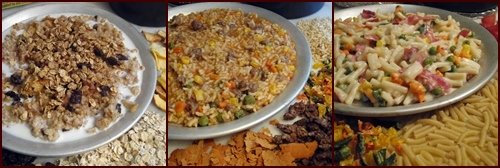
Breakfast:
Cinnamon Oatmeal with Apples & Raisins (R382/L537)
Powdered Milk 2 or 3 Tbsp. = ½ or ¾ cup (R76/L114)
Total Calories: (R458/L651)
Lunch:
Bean Bark Stew (R432/L602)
2 Tortillas, 100 calories ea. (200)
Cheddar Cheese, ¼ or ⅓ cup (R170/L226)
Total Calories: (R802/L1028)
Dinner:
Ham & Cheese Macaroni
(R466/L667)
Dried Sliced Beets, ⅓ cup before rehydration (140)
Fruit Cocktail, Dried ½ cup pears, ¼ cup bananas, ⅛ cup peaches, ⅛ cup pineapple. (233)
Total Calories: (R839/L1040)
Snacks
Sweet Potato Bark ½ or ¾ cup (R248/L372)
Salted Peanuts ½ or ¾ cup (R424/L636)
Dried Bananas ½ or ¾ cup (R93/L140)
Raisins ½ or ¾ cup (R217/L325)
Total Calories Day 1
Regular Servings: 3081
Large Servings: 4192
Day 2
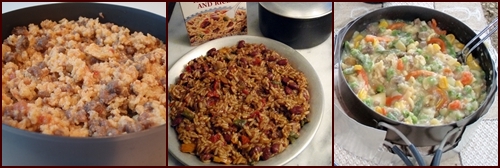
Breakfast:
Scrambled Eggs/Polenta w/ Beef & Salsa (R465/L619)
2 Tortillas, 100 calories each. (200)
Cheddar Cheese,
¼ or ⅓ cup
(R170/L226)
Lunch:
Red Beans & Rice (R413/L506)
Dinner:
Mashed Potatoes w Meat & Vegetables (R422/L601)
Dried Tomatoes, Zucchini, Mushrooms, ½ cup (58)
Pineapple Upside-Down Cake (R452/L678)
Snacks:
Pumpkin Pie Bark ½ or ¾ cup (R107/L160)
Almonds, ½ or ¾ cup (R414/L621)
Granola with M&Ms, ½ or ¾ cup (R220/L330)
Dried Pears ½ or ¾ cup (R137/L205)
Total Calories Day 2
Regular Servings: 3000
Large Servings: 4204
Day 3
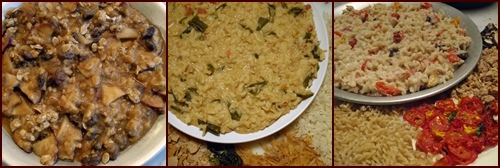
Breakfast:
Sweet Potato Bark Porridge (R500/L719)
Lunch:
Chicken Endhilada Bean Bark Stew (R359/L505)
2 Tortillas, 100 calories ea. (200)
Cheddar Cheese,
¼ or ⅓ cup
(R170/L226)
Dinner:
Tuna Mac & Cheese (R397/L576)
Dried Mixed Vegetables, ½ cup (176)
Banana Nut Bread Pudding (R364/L504)
Snacks:
Pumpkin Pie Bark ½ or ¾ cup (R107/L160)
Cashews, ½ or ¾ cup (R394/L591)
Craisins & M&Ms, ½ or ¾ cup (R395/L592)
Dried Fruits, assorted, ½ or ¾ cup (R116/L175)
Total Calories Day 3
Regular Servings: 3178
Large Servings: 4424
Summary
I packed regular size portions for my first two 30-day backpacking trips where I tested the recipes and menus on the Appalachian Trail. The quantities satisfied my hunger and energy requirements. I supplemented my diet with restaurant and hostel food in the trail towns where I stopped for the night.
I lost ten pounds eating regular size portions for one month. I felt I had ten pounds to spare. For longer thru-hikes, I would pack mostly large portions and extra snacks for each day.
Two benefits of going with the regular portions is that they pack well and are easy to cook using less than ½-ounce of alcohol per meal. Individual snacks and sides in ½-cup portions fit perfectly in 3 x 5 bags and most of the meals fit in 4 x 6 bags. Larger portions require larger bags and a little more fuel which are minor adjustments to make if you need the extra calories.
Explore More...
Share this page with friends on social media.
Free E-book & Newsletter
Free with Trail Bytes subscription.
Dehydrating Food from A–Z


